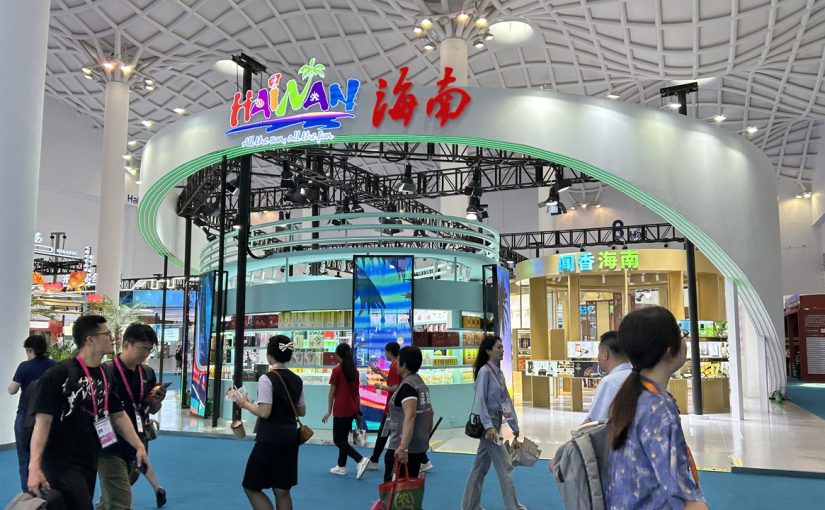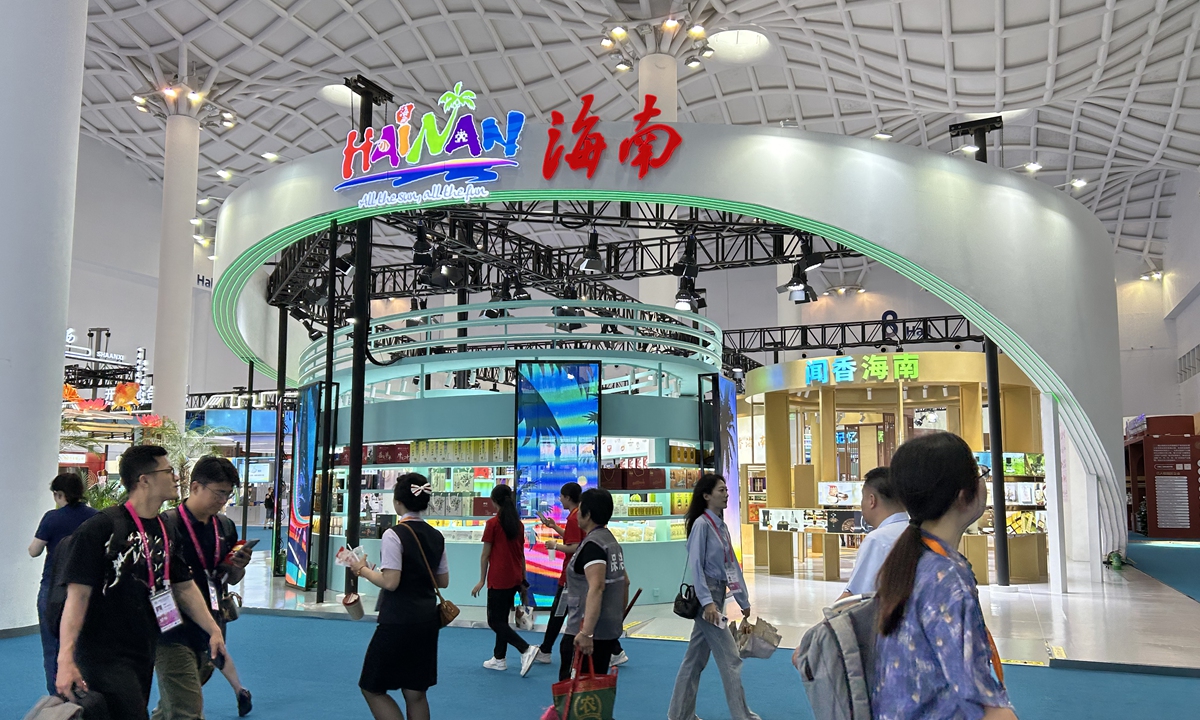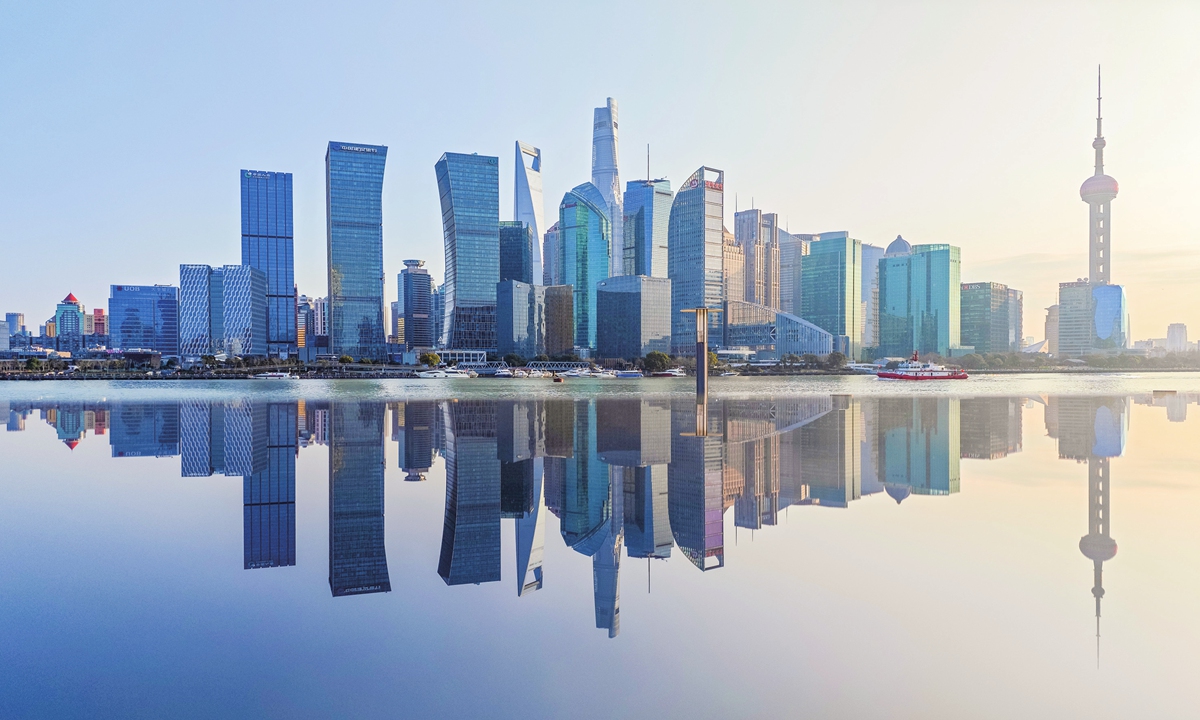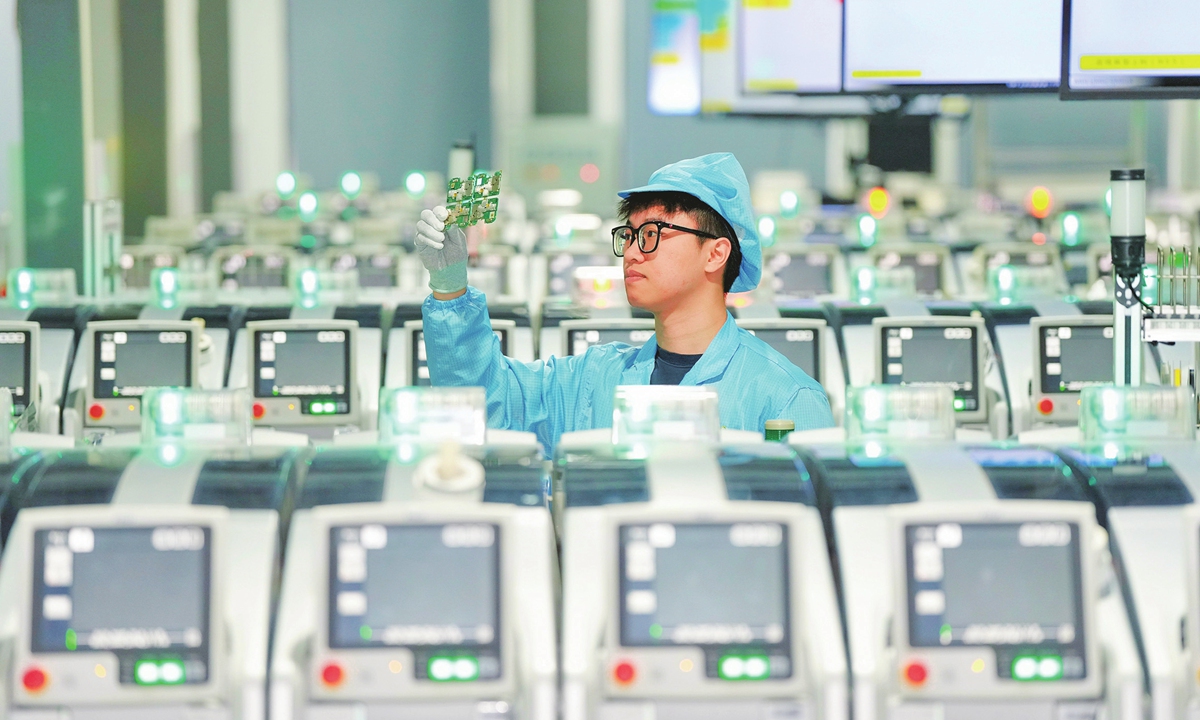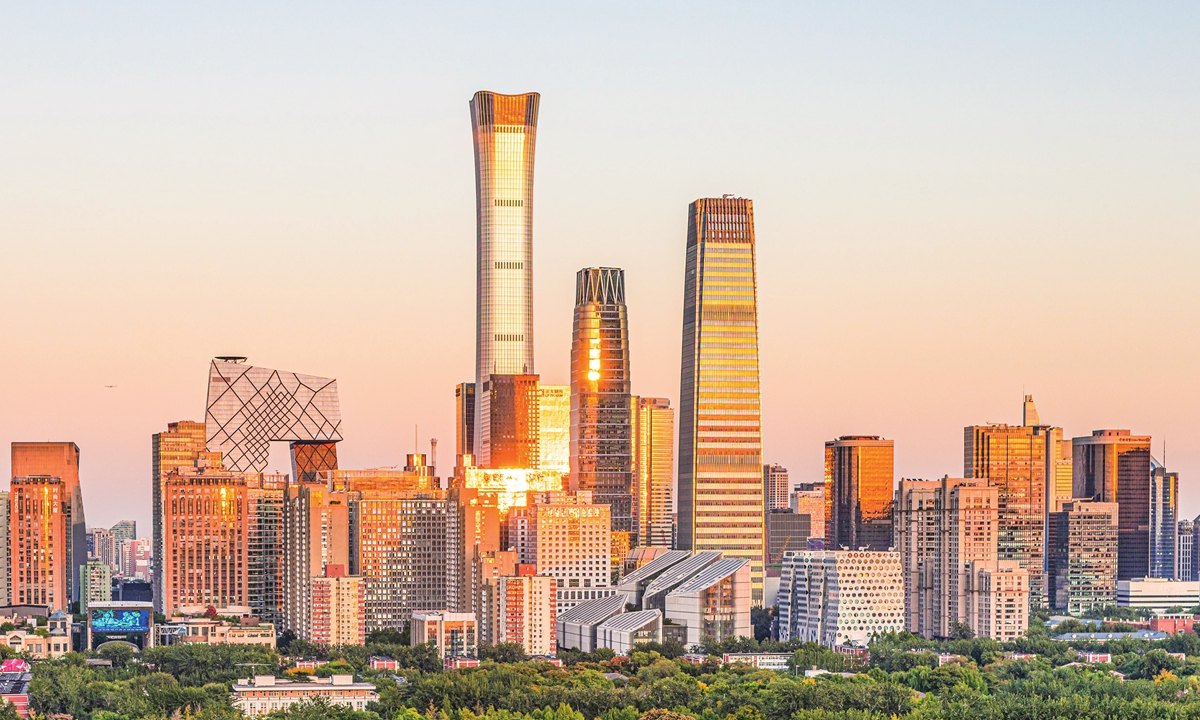
A view of the skyline of Beijing’s CBD area. Photo: VCG
Bearish views about China’s economy appear from time to time but are always proved wrong. Recently, some Western politicians and institutions have come up with the “China peaks” theory, which may seem novel but is exactly the same as the so-called “End of China’s economic miracle” theory back in 2013.
History is a long-cycle development process, and arbitrary claims of “peak” and “end” often go against logic and common sense.
Over the past decade, the Chinese economy has been moving forward and experiencing waves of development, despite the Western hype shifting from “disappointing” to “near collapse.” In 2023, China’s GDP surpassed 126 trillion yuan, with per capita disposable income at 39,218 yuan, more than double the figures of 56.8 trillion yuan and 18,311 yuan in 2013. The 5.2 percent growth rate is also significantly faster than the US’ 2.5 percent, the eurozone’s 0.5 percent, and Japan’s 1.9 percent. With its contribution to world economic growth continues o exceed 30 percent, China remains an important engine of global economic growth.
In the face of the rosy data and solid facts, where did the “China peaks” theory come from?
First, the “pandemic impact” rhetoric says that the COVID-19 pandemic has accelerated the process of peaking.
Indeed, the three-year COVID-19 pandemic has had a significant impact on both the world and the Chinese economy. But historically, no matter how severe a pandemic is, it is a short-term issue. No matter how big the impact on the economy, it will not fundamentally change its long-term development trend. China was the first major economy that saw growth resume after the pandemic. Now, its “scar effect” on China’s economy has faded. Last year, the total retail sales of consumer goods in China exceeded 47 trillion yuan, up 7.2 percent year-on-year, indicating that consumption is again driving economic growth.
Businesses are also booming. Boosted by last year’s May Day holidays and National Day holidays and this year’s Spring Festival, renowned domestic brands have introduced new products, various places have promoted local tourism, and a variety of new consumption scenarios have emerged. Whether it is the night economy in Changsha, or the Hangzhou Asian Games, China’s economic recovery is clear for everyone to see. This surging energy is propelling China’s high-quality development forward with renewed vigor.
Second, the “demographic dividend” narrative argues that, with China’s total population now peaking, the disappearance of the demographic dividend will make China’s growth miracle of the past 40 years unsustainable.
In recent years, significant changes have taken place in the size and structure of China’s population. But there are still about 865 million people aged 16 to 59, who are at working age. With the labor participation rate at a relatively high level in the world, China still has abundant labor resources and its demographic dividend hasn’t gone away. Furthermore, in terms of economic development, the input of the labor force is important, but the input of effective labor is even more important. Effective labor can be defined as the product of the number of workers and their level of education. Essentially, compared with the size of the population, the quality of the population is a key determinant of long-term economic growth.
At present, the average years of education of the working-age population in China have risen to 11.05 years, and the number of people that have had higher education has exceeded 240 million. China boasts the largest number of science and technology professionals, as well as research and development personnel globally. China’s large number of science and engineering graduates has formed an “engineer dividend.” Overall, despite the aging population, effective labor has been increasing every year, transitioning from a “demographic dividend” to a “talent dividend.” This offers solid human resources foundation for high-quality development.
Third, it has been claimed that the US’ technological suppression and decoupling will hinder China’s development. This argument suggests that China is still in the process of technological transformation, and Western tech blockades will impact the development of China’s high-tech industry and stymie China’s economic rise.
Can technological suppression block China’s development path? The question has been answered by history more than once. China has been repeatedly besieged and suppressed, but has been able to overcome difficulties even when the economy was still underdeveloped. Today, given the solid material and technological foundations in China, the so-called “small yard high fence” attitude will not stop China’s innovation and development.
Today, China remains committed to keeping its doors open and continues to advance in technology through independent development. China has increased its investment in technological innovation and achieved remarkable progress.
For instance, the domestically produced C919 large passenger aircraft has entered commercial flights. The homegrown large cruise ship has also started commercial operation, and the Shenzhou series of space missions have achieved remarkable success.
China’s cutting-edge technology field is constantly accumulating energy, demonstrating the strength of Chinese innovation. China has the largest number of global top-100 technology innovation clusters in the world, and emerging technologies such as artificial intelligence and blockchain are growing in importance. New-energy vehicles, lithium batteries, and photovoltaic products have become new highlights of China’s manufacturing industry.
China is leveraging the advantages of a new type of national system with concentrated efforts and resources for important events or projects, with abundant talent, a huge market, and complete industrial support. The innovation drive and development vitality of China are flourishing, and new quality productive forces are emerging, demonstrating strong support for high-quality development.
Fourth, it has been claimed that a slowdown in economic growth suggests that a “peak” has been passed. This claim argues that the miracle of high-speed growth of the Chinese economy brought about by special domestic and international opportunities is unsustainable, and that China will fall into a growth stagnation predicament.
After more than 30 years of high-speed growth with an average annual GDP growth rate of 9.9 percent, the growth rate of the Chinese economy has indeed slowed down in recent years, but this is a natural result of the evolution of economic development.
Throughout history, economies have typically experienced a natural decline in growth rates, transitioning from periods of rapid growth to more stable, moderate growth. This trend is commonly observed in the development of modern economies and is considered an inevitable occurrence.
In the industrialization process of various countries, such as Germany, Japan and South Korea, after experiencing two to three decades of high-speed growth, the pace of the growth will slow down. This is an entirely normal phenomenon.
Moreover, the phased transition of China’s economic growth is intertwined with the long-term structural adjustment of the world economy and the integration of a new round of industrial revolution. If China continues to pursue high-speed growth, it would not only go against economic laws, but also exacerbate the existing contradictions of traditional extensive growth methods, bringing many risks and causing economic imbalance, lack of coordination, and unsustainability.
Transitioning to a new stage of growth also means changing the driving forces. Outdated productivity continues to decline, while advanced productivity continues to emerge, forming new growth momentum.
Observing the theme of high-quality development in the Chinese economy, one should not only look at the size, but also the quality. Combining growth data and efficiency data from recent years, the Chinese economy has not peaked at all, but has achieved a qualitative and effective improvement while overcoming many difficulties.
Currently, China’s comprehensive advantages in human resources, capital formation, infrastructure, and industrial system are outstanding, and the potential for economic development is huge.
For example, the savings rate is still at a high level; a relatively complete and large-scale infrastructure network has been formed; and a large-scale, comprehensive, and strong complementary industrial system has been established. According to calculations by many domestic and foreign research institutions, China’s potential growth rate can still reach around 5 percent for the long run.
Those who repeatedly curse the Chinese economy have had their views rebutted by the facts. Whether it is simply applying Western theories to analyze the Chinese economy, exaggerating short-term issues, having a subjective bias, or acting out of narrow self-interest, the smears are based on misconceptions about the Chinese economy.
The Chinese economy has been advancing steadily, with firm goals and adjustments that keep pace with the times.
Looking into the future, China’s economy has solid support from its huge material and technological foundations, advantages in supply capacity with a complete range of industrial sectors, potential demand advantages from the huge domestic consumer market, talent advantages, advantages in emerging industries, and advantages in continuous institutional innovation through reform and opening-up.
In developing new quality productive forces, the growth potential of the Chinese economy will continue to be unleashed.
China’s economy is currently at a crucial stage of transitioning toward high-quality development. During this process, various problems and challenges are inevitable, such as insufficient effective demand, overcapacity in some sectors, weak social expectations, and numerous hidden risks. China is addressing these problems, making effective use of ample policy space, and continuously introducing targeted measures to resolve them. The performance of China’s economy in 2023 was the best proof.
American scholar George Friedman, who announced the “end of the Chinese economic miracle” a decade ago, wrote that “no one country can replace China, but China will be replaced. The next step in this process is identifying China’s successors.”
Ten years on, China has recorded ever outstanding and profound development achievements: The next China is still China!
The article is an economic commentary first published in The Economic Daily. [email protected]
